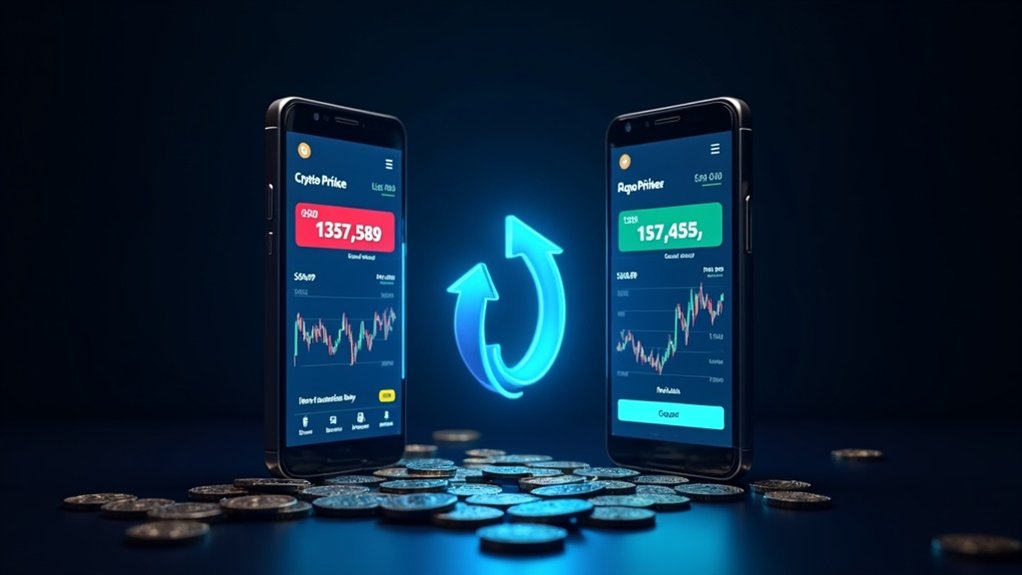Flash loans are DeFi’s no-collateral borrowing innovation. They must be repaid within the same blockchain transaction—complete successfully or fail entirely. Smart contracts enforce these strict rules. Crypto traders use them for arbitrage, swapping collateral, or executing complex strategies without upfront capital. Not for beginners, though. These loans carry risks of smart contract exploits and have been linked to major hacks. Fees typically range from 0.05% to 0.3%. The deeper mechanics reveal both opportunity and danger.
Securing a loan without a bank breathing down your neck? In the DeFi world, that’s becoming increasingly possible through flash loans—a revolutionary lending mechanism that doesn’t require collateral.
Unlike traditional collateralized crypto loans where borrowers must deposit assets worth more than they’re borrowing (typically 110% to 300% of the loan amount), flash loans operate on a completely different principle.
Flash loans are uncollateralized but with a major catch. They must be borrowed and repaid within a single blockchain transaction. Yep, you read that right. One transaction. These loans exist in a bizarre temporal bubble where you either return the money with interest before the transaction completes, or the whole thing gets canceled like it never happened. Pretty convenient, right?
Smart contracts make this possible. They’re ruthlessly efficient at enforcing rules. The code simply won’t allow the transaction to complete unless the loan is repaid in full. No exceptions, no excuses, no sob stories about your dog eating your crypto keys. Similar to crypto derivatives, these contracts derive their functionality from underlying crypto assets.
DeFi platforms like Aave and dYdX pioneered these flash loans, enabling users to access substantial liquidity for split-second opportunities. Aave charges minimal fees of just 0.05% fee for their flash loan services. Traders use them for arbitrage between exchanges, swapping collateral on other loans, or executing complex strategies that would otherwise require significant capital. It’s financial gymnastics at its finest.
The risks? They’re not for amateurs. Smart contract vulnerabilities could lead to catastrophic failures. Several high-profile DeFi hacks have exploited flash loans to manipulate market prices and drain protocols. Flash loans were involved in the Poly Network hack that resulted in over $600 million stolen in 2021. The ecosystem is still maturing, and security remains an ongoing concern.
Interest rates for flash loans are typically flat fees rather than annual rates, usually ranging from 0.09% to 0.3%. Small price to pay for temporary access to millions in capital.
While traditional collateralized loans help hodlers access liquidity without selling their precious coins, flash loans serve a different purpose altogether—they’re financial power tools for the crypto-savvy. Handle with care. Or don’t. The blockchain doesn’t really care either way.
Frequently Asked Questions
What Are the Risks Associated With Flash Loans?
Flash loans present significant risks to DeFi ecosystems. They enable attackers to exploit smart contract vulnerabilities, causing massive financial losses in seconds.
Price manipulation destabilizes markets. Liquidity pools get drained. One exploit can trigger cascading failures across connected protocols. Trust evaporates when platforms get hit.
Security teams struggle to detect these complex attacks in real-time. And now regulators are circling like sharks.
The anonymous blockchain world makes catching culprits nearly impossible. No security audit is bulletproof.
Can Individual Investors Access Flash Loans Easily?
Individual investors can access flash loans, but “easily” is stretching it.
They’re technically open to anyone with smart contract knowledge. No gatekeepers here. But there’s a catch – you need technical skills or must use specialized interfaces.
Not exactly beginner-friendly stuff. Gas fees can be prohibitive for smaller players, and the competition is fierce.
Flash loans are democratic in theory, elitist in practice. The barrier isn’t permission; it’s technical proficiency.
How Do Flash Loan Attacks Happen?
Flash loan attacks happen when hackers borrow massive amounts with no collateral, then execute a series of rapid transactions in one atomic block.
They typically manipulate prices on DEXs, exploit weak oracles, or swap collateral values. The entire operation happens in seconds. Some attackers have stolen hundreds of millions this way.
The kicker? If something fails, the transaction reverts completely – zero risk for the attacker. Pretty slick criminal scheme, honestly.
Are Flash Loans Regulated by Government Financial Authorities?
Flash loans exist in a regulatory gray zone. Most government financial authorities haven’t established specific regulations for them yet.
The decentralized nature makes traditional oversight difficult—no intermediaries to regulate. Some countries are considering frameworks, but implementation remains spotty at best.
DeFi platforms offering flash loans typically don’t comply with AML or KYC requirements.
Honestly, regulators are playing catch-up. They’re struggling to apply old-school financial rules to this new technology. Classic government move.
Which Defi Platforms Currently Offer the Best Flash Loan Terms?
Aave leads the pack with its 0.09% fee structure and robust Safety Module for protection. Not bad.
Cream Finance offers quick liquidity access while Uniswap V3’s flash swaps work similarly but focus on trading.
dYdX brings flash loans to Layer 2, cutting gas costs markedly.
Balancer’s flexible terms cater to arbitrage hunters.
The best platform? Depends what you’re after.
All require repayment in one block—fail that, and your transaction’s dead. Simple as that.









